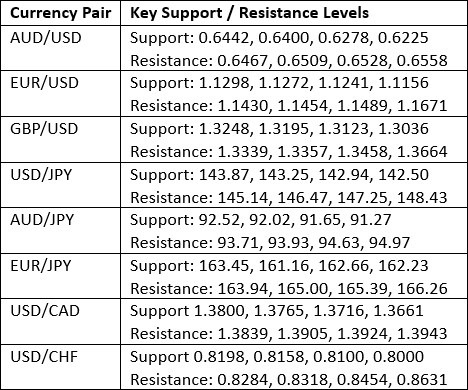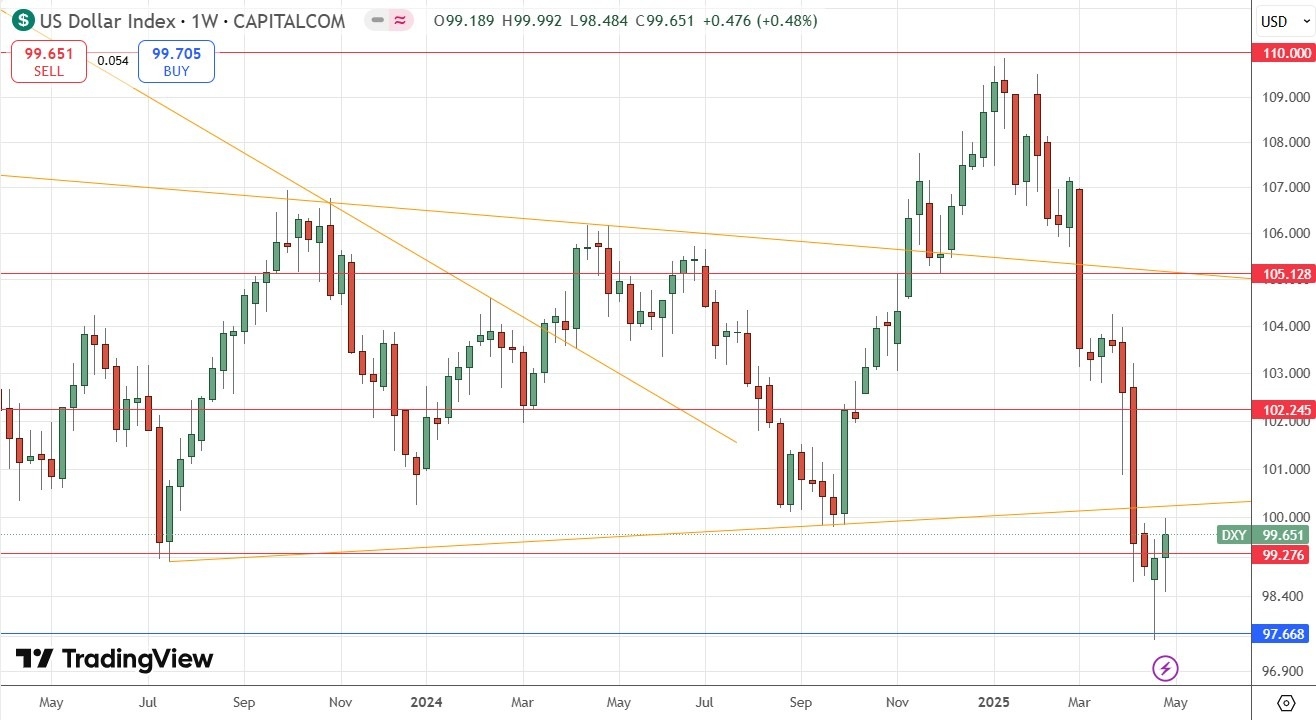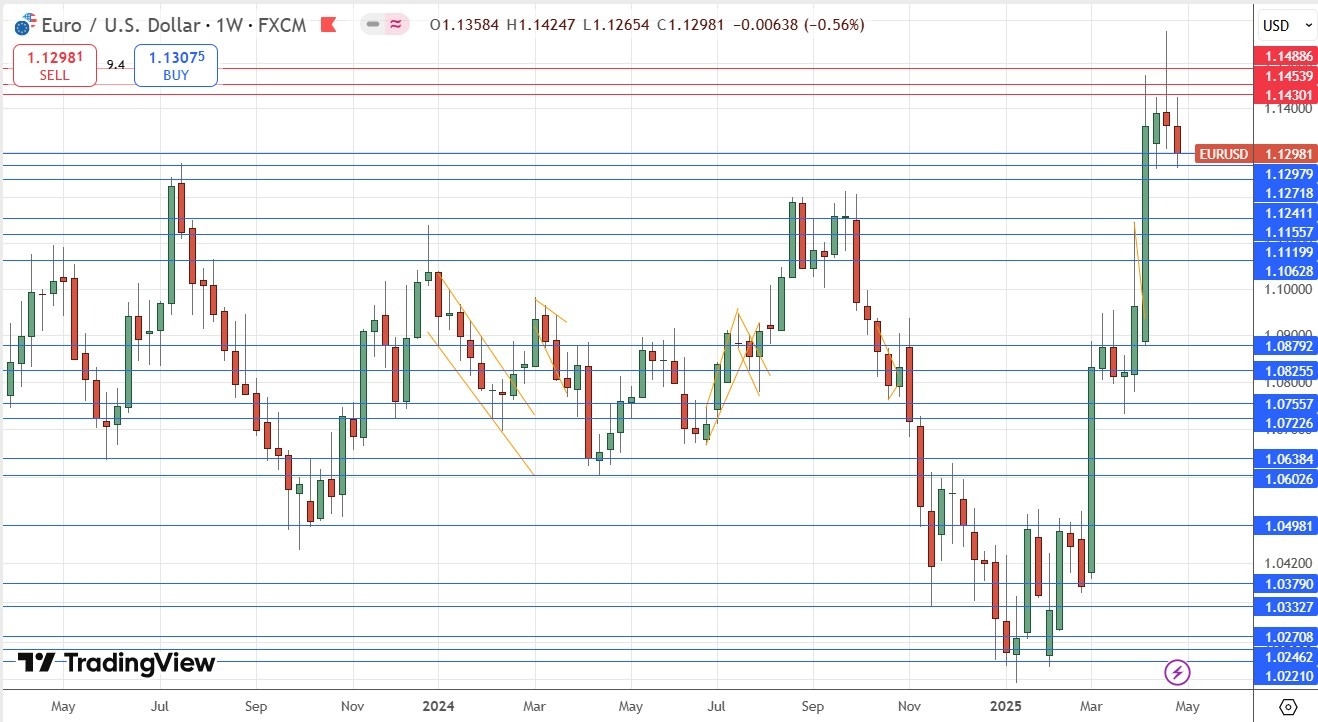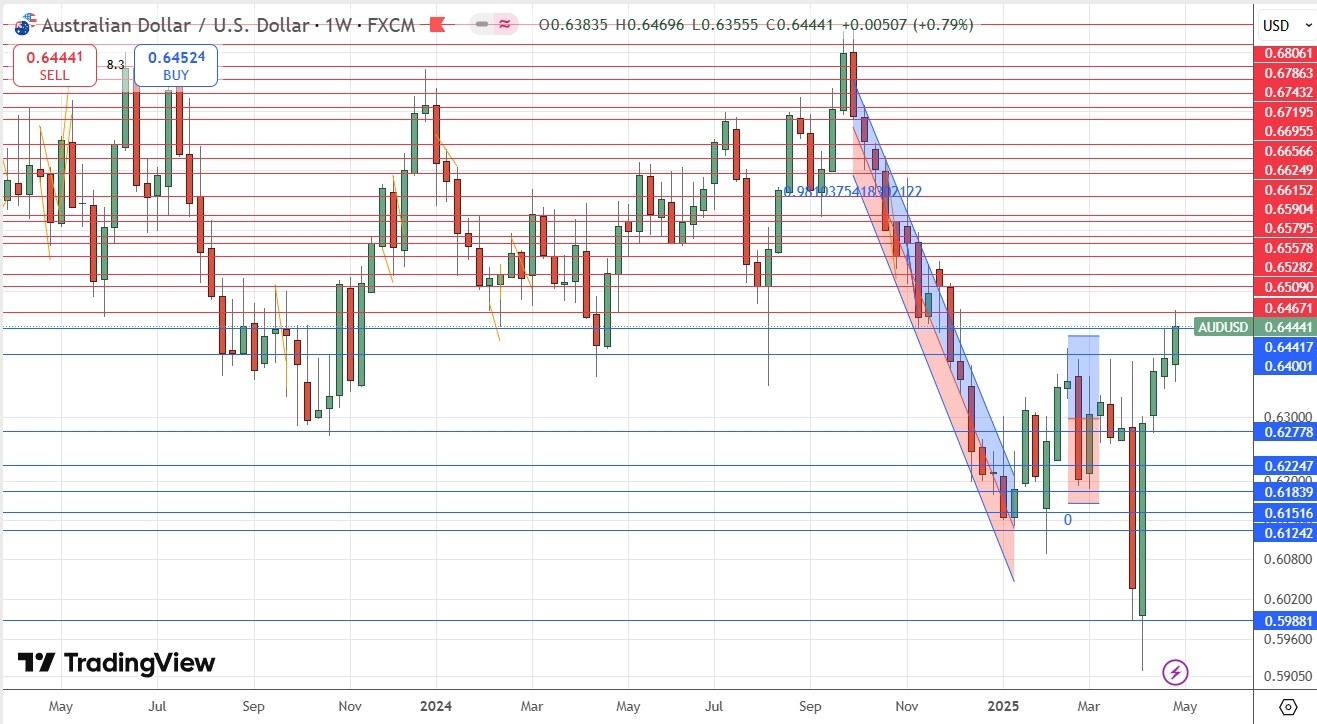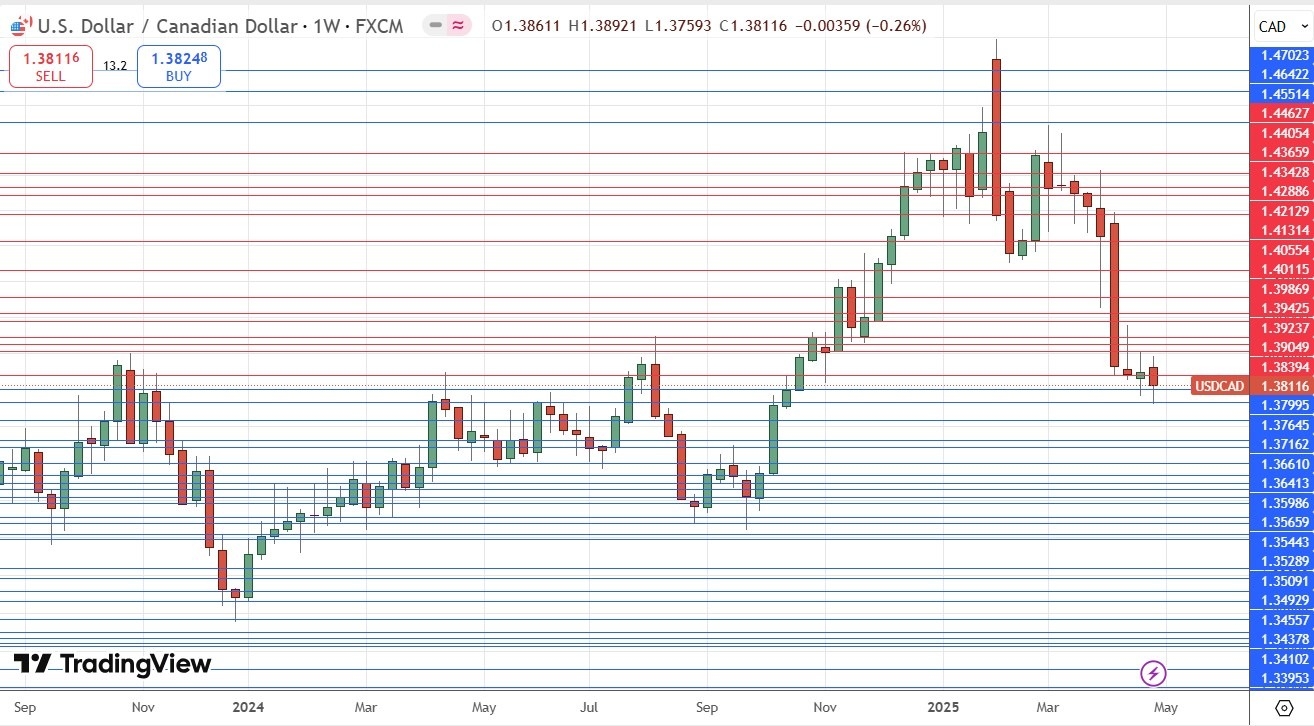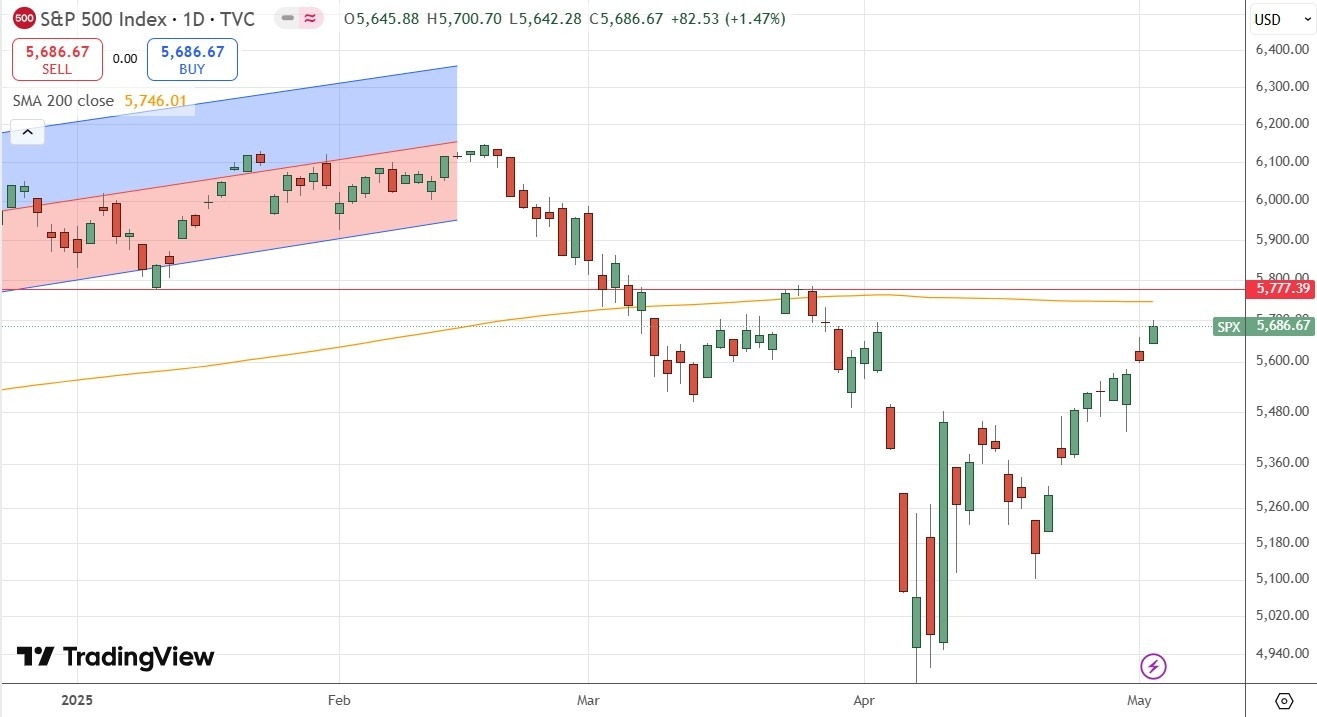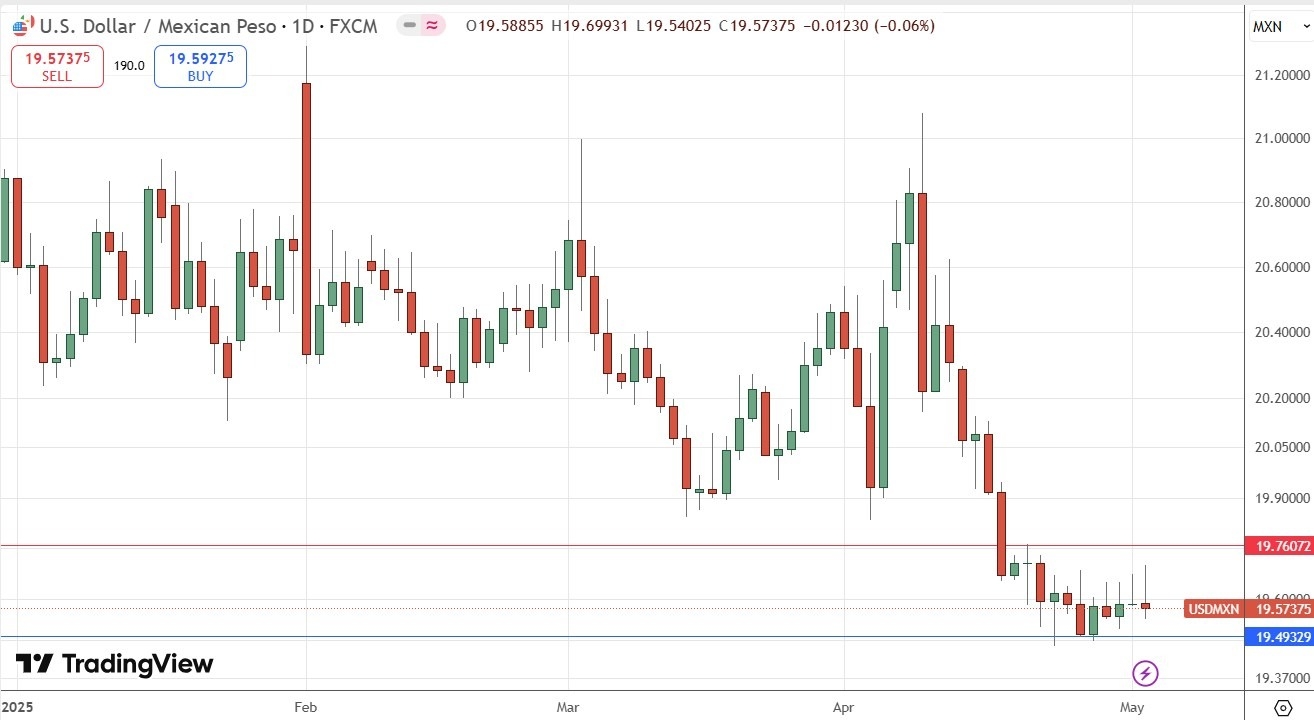Weekly Forex Forecast - Sunday, May 4

Image Source: Pixabay
Fundamental Analysis & Market Sentiment
I previously wrote on Sunday, April 27, 2025 that the best trades for the week would likely be the following:
- Long of the EUR/USD currency pair following a daily (New York) close above $1.1517. This did not set up.
- Short of the USD/JPY currency pair following a daily (New York) close below JPY140.75. This did not set up.
- Long of gold following a daily (New York) close above $3,425. This did not set up.
- Short of the USD/MXN currency pair. This rose by 0.39% over the week.
The overall result was a loss of 0.39%, which was 0.10% per asset.
Meanwhile, last week saw a calmer and more bullish market as we seem to have moved beyond any new tariff bombshells. Negotiations will be ongoing until the 90-day period ends in early July. You can see the areas hit hardest by the tariff issue are the ones which are now doing the best, such as the US dollar and even more so, commodity currencies such as the Canadian and Australian dollars.
Beyond that, although not especially significant, the major events of last week were the lower-than -expected inflationary indicators in the US, but the surprise was the shrinking GDP data which might indicate the start of a recession. Despite that, the week ended with US stock markets and the US dollar firmly higher.
Last week’s major data points were the following:
- US Core PCE Price Index – this came in a fraction lower than expected, showing no change over the month, which was logically bearish for the greenback but bullish for US stocks.
- US Average Hourly Earnings – this came in a fraction lower than expected, showing only a 0.2% increase on the month, which reinforced the point above.
- US Non-Farm Employment Change – this was larger than expected, somewhat contradicting the potentially recessionary Advance GDP data.
- US Advance GDP – this showed a 0.3% decline over the past month, when it was expected to increase by 0.2%. This shook the greenback and US stocks somewhat earlier in the week when the data was released.
- German Preliminary CPI – this was slightly higher than expected, printing a 0.4% month-on-month increase.
- Australian CPI (inflation) – this was a fraction higher than expected, leaving the annualized rate unchanged at 2.4%, which makes a rate cut a little less likely, helping to boost the already strong Aussie.
- Bank of Japan Policy Rate, Monetary Policy Statement, and Outlook Report – there were no surprises, and rates were left unchanged.
- Canadian GDP – this showed a contraction month-on-month of 0.2%, so like the US, we may have seen the first indication that a recession is starting. This seems to have had little effect on the Loonie though, which remains strong.
- Canadian Federal Election – the governing Liberals won a narrow victory but only managed to secure a minority government.
- Australian Parliamentary Election – the result was a surprise, with the governing Labor party winning a landslide majority. This is the first Australian government to be re-elected with a majority since over 20 years ago.
- US JOLTS Job Openings – this came in worse than expected, with 7.2 million jobs compared to the 7.5 million anticipated.
- US ISM Manufacturing PMI – this came in practically as expected.
- US Employment Cost Index – this was as expected.
- US Unemployment Claims – this came in practically as expected.
- US Unemployment Rate – this was as expected.
- Chinese Manufacturing PMI – this came in practically as expected.
The Week Ahead: May 5-9, 2025
The coming week has a less intense schedule of important releases, but it notably will include policy meetings at the US Federal Reserve and the Bank of England. This week’s important data points, in order of likely significance, are the following:
- US Federal Funds Rate/Statement
- Bank of England Policy Rate/Summary/Report
- Swiss CPI
- US ISM Services PMI
- US Unemployment Claims
- Canada Unemployment Rate
- New Zealand Unemployment Rate
Monthly Forecast for May 2025
(Click on image to enlarge)
For the month of April 2025, I did not provide a monthly forecast. This was because the Forex market was dull and there were only mixed long-term trends to be found at the start of the month.
For the month of May 2025, I once again will not give a monthly forecast for similar reasons. Although there is a long-term trend against the US dollar, the price action suggests a major bullish reversal could be underway.
Weekly Forecast for Sunday, May 4, 2025
As there were no unusually large price movements in Forex currency crosses over the past week, I will not give a weekly forecast.
The Australian dollar was the strongest major currency last week, while the Japanese yen was the weakest. Volatility decreased again over this period, as only 22% of the most important Forex currency pairs and crosses changed in value by more than 1%. Next week will likely see similar volatility as there will be two high-impact central bank policy meetings, including one in the US.
Key Support/Resistance Levels for Popular Pairs
Technical Analysis - US Dollar Index
Last week, the US Dollar Index printed a bullish candlestick which closed above the former resistance level at 99.27. The price reached a new four-year low a couple of weeks ago, before it bounced strongly off the support level shown in the price chart below, at the 97.67 mark. As the rise has continued, these are bullish signs, but the strong long-term bearish trend is a bearish sign.
It is hard to say what will happen to the US dollar next week after this bullish bounce, but trading in line with the long-term trend would be short of the greenback. Much may depend on the FOMC meeting scheduled for Wednesday this week. It did not seem last week as if the poor GDP data and slightly better-than-expected average hourly earnings data had much impact on the price of the greenback.
(Click on image to enlarge)
EUR/USD
The EUR/USD currency pair fell again last week with a moderately bearish candlestick which followed the previous week’s bearish pin bar. This is a bearish sign and suggests we may have seen a major bearish reversal. However, the long-term trend is still bullish, the price has recently been trading in blue sky territory, and this currency pair tends to trend slowly but reliably.
So, it may still be worth being involved on the long side here, but I’d want to see a new significant bullish breakout first. If we see a daily (New York) close below about $1.1260, that would shake out a lot of trend traders from any existing long positions. The support level at $1.1241 could also be significant if it breaks down.
If the price could get established above the $1.1517 mark, that would probably be a good long trade entry signal, as there are no key resistance levels above that area for a few hundred pips.
(Click on image to enlarge)
AUD/USD
The AUD/USD currency pair printed a bullish candlestick last week, with the Aussie being one of the few major currencies which gained against the US dollar over the past week – as it was commodity currencies which performed the best over recent days.
We have seen four consecutive weeks of strong gains, and the momentum seems to be holding steady as risky assets continue to recover in this macro environment, notably including stock markets, and the Aussie typically goes along with that.
The price traded at a near five-month high last week, and with the solid result in the Australian election over the weekend producing a majority government, we may see the Aussie and the Australian stock market remain in a bullish move as the week begins in Asia.
Unfortunately, this currency pair tends to trend unreliably, so I do not like to follow trends here and I cannot suggest a trend-following opportunity. It could be that we have already seen a significant bearish double top at the $0.6470 mark.
(Click on image to enlarge)
USD/CAD
The USD/CAD currency pair fell again last week, continuing its long-term bearish trend, although the trend seems to be running out of momentum as the supportive area below the $1.3800 figure continues to hold.
The bearish trend is one of the few surviving long-term trends against the US dollar, with the price above its levels of both three and six months ago.
The Canadian dollar has been strong as a commodity currency as risk-on sentiment has continued to recover after the Trump Administration successfully kicked the tariffs can down the road to July, although this will resurface as an issue before then. The successful re-election of the Canadian government is also contributing to the stronger Loonie.
Despite the clear long-term trend, I don’t find this pair’s trends to be very reliable. Yet the relative strength in the Canadian dollar could make it a good long counterparty for a Forex trade this week where the focus is on the currency to go short of.
(Click on image to enlarge)
The S&P 500 Index
The S&P 500 Index advanced again last week on improved risk sentiment, despite the surprisingly negative Advance GDP data. The price has risen enough to get quite close to the 200-day moving average and the confluent resistance levels at 5713 and 5786. If the price can continue its advance over the coming week and get established above this structure, that would be a bullish sign. The price has already advanced by more than 17% since the big low was made barely four weeks ago.
Despite the bullish potential, it may be that this resistant area near the 200-day moving average holds as resistance and produces a bearish reversal.
Traders who were active during and after the coronavirus crash of 2020 might find the current situation familiar, although the 2020 decline was much stronger and faster than what we saw here at the height of the panic over Trump’s tariffs. What was unusual about 2020 was the recovery – the price just kept going up and up from the low, when it might have been expected to bump around for a while, as bear markets typically take at least several months to play out.
Shorting US equity indices is often very risky and probably not advisable to anyone except a very experienced trader. This is especially true as we are now seeing such signs of resilience.
I believe there is going to be more turbulence in the stock market over the coming months as we approach the 90-day tariff deadline in early July, so I am happy to be out of stocks for now. However, if the price ends the week near the weekly high and above the 5786 mark, the bullish case would look stronger.
(Click on image to enlarge)
USD/MXN
The USD/MXN currency pair has continued to look heavy as it weighs on the key support level at $19.4933, which is confluent with the major half-number at $19.5000. If the price breaks below this area, it could continue to fall strongly and quickly.
Despite the greenback’s recovery over the past couple of weeks, the Mexican peso has been one of the very few currencies which continues to show strength against the greenback as well as standalone long-term relative strength.
The fundamental driver behind the strong Mexican peso is the way the trade war between the US and Mexico has been defused, at least until late June. Absent any sign of worse US intentions, the price could be prone to making a sharp bearish breakdown below the $19.4933 level.
If we get a daily (New York) close below the $19.4933 mark, I will enter a short trade.
(Click on image to enlarge)
Bottom Line
I see the best trades this coming week as the following:
- Long of the EUR/USD currency pair following a daily (New York) close above $1.1517.
- Short of the USD/MXN currency pair following a daily (New York) close below $19.4333.
More By This Author:
Forex Today: Polls Point To Narrow Liberal Victory In Today's Canadian Election
Weekly Forex Forecast – EUR/USD, USD/JPY, Gold, S&P 500 Index, USD/MXN
Weekly Forex Forecast - Sunday, April 20
Risk Disclaimer: DailyForex will not be held liable for any loss or damage resulting from reliance on the information contained within this website including market news, analysis, trading signals ...
more

